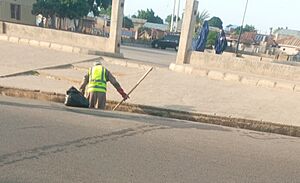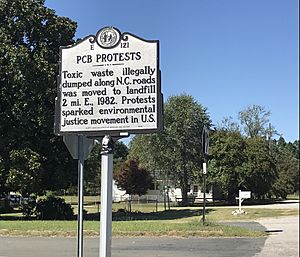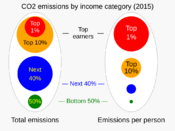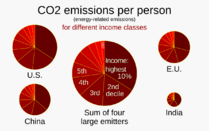Environmental justice facts for kids
Environmental justice is a social movement that fights for fairness in how the environment affects people. It works to make sure that communities, especially those that are poor or have been treated unfairly in the past, are not harmed by things like hazardous waste, pollution from factories, or the taking of natural resources.
Studies have shown that some groups of people face more environmental harm than others. For example, communities of color or low-income families are more likely to live near sources of pollution. They are also often hit hardest by natural disasters.
The movement for environmental justice started in the United States in the 1980s. It was inspired by the American civil rights movement and first focused on environmental racism, which is when environmental problems unfairly affect people of a certain race.
Over time, the movement grew to include the whole world. It now also looks at how environmental issues affect women, LGBTQ people, and people in poorer countries, often called the Global South. The movement has become so important that its goals are now discussed by the United Nations. It is closely connected to movements for Indigenous land rights and the human right to a healthy environment.
The main goal of the environmental justice movement is to give all communities, especially those that have been ignored, a voice in decisions that affect their environment and their health. Often, local groups of environmental defenders find themselves standing up to large companies to protect their homes. These local fights are now often supported by a worldwide network of people who believe in environmental justice.
Contents
What is Environmental Justice?
Environmental justice is about making sure everyone is treated fairly when it comes to the environment. It looks at many different ideas of what "fair" means.
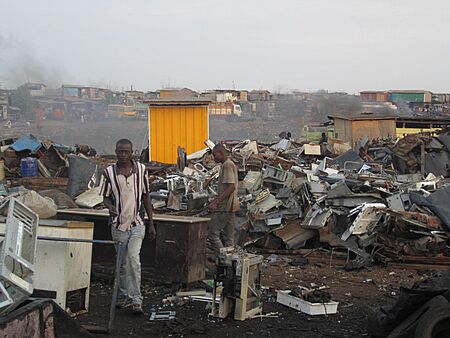
The United States Environmental Protection Agency (EPA) defines environmental justice as:
the fair treatment and meaningful involvement of all people regardless of race, color, national origin, or income with respect to the development, implementation, and enforcement of environmental laws, regulations and policies. Fair treatment means that no group of people... should bear a disproportionate share of the negative environmental consequences...
This means two main things:
- Fair Treatment: No group of people should have to deal with more pollution or environmental dangers than anyone else. For example, a town with mostly low-income families should not be chosen as the place for a new landfill just because the people there have less political power to fight it.
- Meaningful Involvement: Everyone should have a real chance to participate in decisions about their environment. This means meetings should be held at times and places where people can actually go, and information should be easy to understand.
Environmental justice is sometimes called environmental inequality or discussed as part of environmental racism.
Justice for Indigenous Peoples
For Native American and other Indigenous communities, environmental justice is deeply connected to their history, culture, and rights to their land. Their view of justice is often different from the legal systems in countries like the United States.
For Indigenous peoples, land is not just property that can be bought and sold. It is a central part of their culture, spirituality, and way of life. Environmental harm, like pollution from a mine or an oil pipeline, doesn't just lower property values—it can damage a culture that has existed for thousands of years. Therefore, for these communities, environmental justice is also about protecting their traditions and their right to govern their own lands.
History of the Movement
While people have faced environmental unfairness for centuries, the modern environmental justice movement gained attention in the United States in the late 1970s and early 1980s.
A key moment happened in 1982 in Warren County, North Carolina, a poor county with a large African American population. The state government decided to build a landfill there to dump soil contaminated with toxic chemicals called PCBs.
The people of Warren County knew this was unfair. They believed their community was chosen because it was poor and mostly Black. For six weeks, they organized peaceful protests to block the trucks carrying the toxic soil. Over 500 people were arrested, including children and civil rights leaders.
Even though the landfill was built, the protests in Warren County were very important. They brought national attention to the problem of environmental racism. Rev. Benjamin Chavis, one of the leaders, is credited with coining the term "environmental racism" during this time. The protests inspired people across the country to look at where landfills and factories were being built in their own areas.
After the protests, studies were done that proved what the protesters had been saying. A famous 1987 report by the United Church of Christ found that race was the most important factor in deciding where hazardous waste facilities were located in the United States.
This led to more action. In 1994, President Bill Clinton signed an Executive Order on Environmental Justice. This order required the U.S. government to make environmental justice a goal for all its agencies.
Environmental Problems and Unfairness
The environmental justice movement works to fix many kinds of unfairness. These problems often happen when one group benefits from something, while another group suffers from the negative consequences.
Environmental Racism
Environmental racism is a term for how communities of color are more likely to be exposed to pollution and other environmental dangers. This is not usually because of one person's prejudice, but because of a system of rules and decisions that have unfair results.
For example, for many years, practices like "redlining" in the U.S. made it hard for people of color to get loans to buy houses in certain neighborhoods. This often forced them to live in industrial areas closer to factories, highways, and waste sites. Today, these same communities often have higher rates of health problems like asthma because of the poor air quality.
Hazardous Waste
In the 1980s and 1990s, as rules about getting rid of toxic waste became stricter in rich countries, some companies started shipping their waste to poorer countries in the Global South. This was cheaper because those countries often had weaker environmental laws.
A famous example is the Khian Sea incident. A ship carrying toxic ash from Philadelphia searched for a place to dump its cargo. After being turned away by several countries, the crew illegally dumped thousands of tons of the ash on a beach in Haiti. This event helped lead to the creation of the Basel Convention, an international treaty to control the movement of hazardous waste between countries.
Taking Natural Resources
Resource extraction is the process of taking natural resources like oil, gas, minerals, or timber from the earth. This often happens on or near land where Indigenous and other local communities live.
While these projects can make a lot of money for big companies and national governments, they often leave the local communities with polluted water, damaged land, and health problems. The people who live there rarely get a say in the decision-making process or share in the profits. In some places, conflicts over resources have led to serious problems and dangers for local people who try to defend their land.
Health Problems
Living in a polluted environment can make people sick. People in environmental justice communities often have higher rates of:
- Asthma and other respiratory problems from air pollution.
- Stomach and other illnesses from contaminated water.
- Other serious health conditions linked to long-term exposure to chemicals.
Children are especially at risk. Their bodies are still developing, so they are more affected by toxic chemicals. They can be exposed to these dangers at home, at school, or on the playground.
Climate Justice
Climate change is one of the biggest environmental justice issues in the world today. Climate justice is the idea that we must address climate change in a way that is fair to everyone.
Wealthy countries in the Global North have produced most of the pollution that is causing climate change. However, the worst effects of climate change—like rising sea levels, more extreme storms, and droughts—are being felt most by poor countries in the Global South. These are the countries that did the least to cause the problem.
Within countries, the same pattern holds true. Low-income communities and communities of color are often less able to protect themselves from heat waves, floods, and other climate-related disasters. Climate justice means that the solutions to climate change, like switching to clean energy, should also help the communities that have been harmed the most.
Around the World
Environmental justice is a global movement. People in communities all over the world are standing up to protect their homes and their health.
Africa
- Nigeria: In the Niger Delta, decades of oil drilling by companies like Shell have led to massive oil spills, polluting the water and farmland of the Ogoni people. Activists like Ken Saro-Wiwa led nonviolent protests to demand that the oil companies clean up the pollution and share the oil wealth with the local people.
- South Africa: During the time of apartheid, the government forced Black South Africans to live in separate, often polluted areas. After apartheid ended in 1994, the new constitution included the right to an environment that is not harmful to health. Groups like Earthlife Africa continue to work on issues like pollution from mining.
The Americas
- United States: The area in Louisiana along the Mississippi River known as "Cancer Alley" has a large number of chemical plants and refineries. The mostly African American communities there have very high rates of cancer and other diseases. In another important case, Held v. Montana, sixteen young people sued the state of Montana in 2020 for promoting fossil fuels that contribute to climate change. In 2023, a judge ruled in their favor, saying they had a right to a clean and healthful environment.
- Ecuador: For decades, oil drilling in the Amazon rainforest by the company Texaco (now part of Chevron) left behind terrible pollution. Indigenous groups have been fighting in court for years to get the company to clean up the damage to their land and water.
- Canada: Many environmental justice conflicts in Canada involve the rights of First Nations communities. Protests have occurred over pipelines, logging, and industrial pollution, such as the mercury poisoning in the Grassy Narrows community, which has affected the health of the people for generations.
Asia
- China: Rapid industrial growth in China has led to serious air pollution in many cities. This pollution causes major health problems for millions of people. The government is now working to reduce pollution, but it remains a huge challenge.
Australia
In Australia, many environmental justice issues involve mining projects on the traditional lands of Aboriginal peoples. For example, the Yeelirrie Uranium Mine in Western Australia was opposed by the local Tjiwarl people, who were concerned about the destruction of their sacred sites and the radioactive waste the mine would create.
Relationships to Other Movements
Environmental justice is connected to many other movements for fairness and a better world.
- Environmentalism: The mainstream environmental movement has historically focused on protecting wilderness and endangered species. The environmental justice movement brought a new focus on how environmental problems affect people, especially the poor and people of color. It argued that a healthy planet and healthy people go hand-in-hand.
- Women's Rights: Women are often the leaders in local environmental justice fights. They are frequently the first to notice health problems in their children and communities. Groups like the Women's Earth and Climate Action Network (WECAN) work to make sure women's voices are heard in environmental decisions.
See also
 In Spanish: Justicia ambiental para niños
In Spanish: Justicia ambiental para niños
- Climate resilience
- Ecocide
- Environmental dumping
- Environmental Justice Foundation
- Fenceline community
- Global waste trade
- Green New Deal
- Health equity
- Human impact on the environment
- Rights of nature
- Sustainable development


